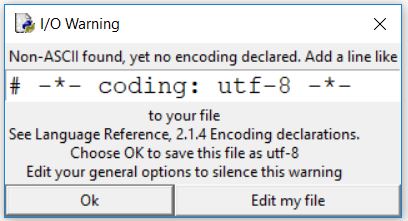Python 教程——String的内置方法
2018-02-03 20:03
483 查看
Python为String类型提供了很多很有用的内置方法,这篇文章主要针对Python2.7的内置方法做一个测试列举,展示一下用途。
如果大家想看原版的,可以去这个网址看(https://docs.python.org/2/library/stdtypes.html#string-methods),但是这里是我自己的实践以及一些理解。
1.
返回第一个字母大写的str
2.
返回一个width宽的string,其中str居中显示,如果有多余的字符,则以fillchar来填充,若没有指定fillchar,则默认使用空格。这个方法主要的功能在于输出一致长度的内容,这边举一个小的应用:
执行上述代码,则会输出如下的一颗树:

3.
返回sub在str内部从start到end为止(不包括end),不重叠出现的次数
4.
在Python中,从Unicode转为其他编码方式成为encode,反之成为decode。所以这个方法返回将用encoding编码的str恢复为unicode,输出是一个unicode的字符串。errors是对于解码过程中出错时候的处理方式,主要有以下几种

5.
将str用encoding的编码方式转为字符串。errors和上述表格一致。
现在将4,5 这两个方法结合在一起展示一个例子:
代码第一行:在python源码中如果使用了中文字符,运行时会有错误,解决的办法是在源码的开头部分加入字符编码的声明,在自带的编辑器内如果不加的话在会出现如下的报错弹出框:

第5行指定了encoding的参数为"utf-8", 则print a的时候可以正常输出中文两个字,如果是第6行这样不指定的,使用的是默认的编码方式,在Python2的自带编辑器内,是ASCII。那么ASCII是无法编码中文的,所以运行时在shell内会输出报错,第8行将unicode又重新编码回普通的string,输出中文两个字。
关于Python中的编码解码问题可以看一下这个链接:https://my.oschina.net/leejun2005/blog/74430
6.
判断 str是不是以suffix结尾,start和end指定开始和结尾,不包括end所在的字符。suffix可以是一个tuple,包含多个suffix
输出
7.
根据指定的tabsize来扩展str中的tab,tabsize的默认值是8
这边引用一个stack overflow(https://stackoverflow.com/questions/34546171/python-expandtabs-string-operation)上的一段代码来作为例子:
8.
find 可以找到sub在str(start和end不包括end之间)内的index。如果要判断一个sub是不是在str中,用in
9.
str中可以用{numeric},或者是{key} 来指代要被格式化的部分,然后在format中,用tuple或者是dict来给str中的那些部分赋值
10.
和find一样,获取sub在str中的index,但是如果找不到的话,会raise valueError()
11.
判断str是不是只包含数字或者字母,并且长度至少为1,如果是的话则返回True,否则False
12.
如果str中只包含字母,并且长度大于1,则返回True,否则返回False
13.
判断str中是否只有数字并且长度大于等于1,是的话返回True,否则返回False
14.
如果str中全是小写字符并且str至少包含一个小写字母,则返回True,否则返回False
15.
如果str中全是空格并且str的长度大于等于1,则返回True,否则返回False
16.
如果str中的每个word都首字母大写而且str至少包含一个大写字母,则返回True,否则返回False
17.
如果str中的字母都是大写,并且str中至少包含一个大写字母 ,则返回True,否则返回False
18.
iterable是一个序列的迭代器,如果这个序列包含了string和unicode之外的类型,则join会出错,如果序列中包含了unicode,则最后返回一个unicode。这个方法将序列中的每个元素用str来连接起来
19.
返回一个width长的string,其中str左对齐,剩余的位置用fillchar补齐,fillchar默认是空格。如果width<len(str) ,则返回str
20.
将str中的字母都换为小写字母再返回,数字无所谓大写小写,会保持不变
21.
从左边开始,将str中的chars的位置删除,直到遇到第一个不符合的位置为止,如果不提供chars,则删除空格。如果从左边开始的第一个字符不符合chars中的任何一个,则不会删除任何字符
22.
将str用sep分隔,并且返回一个包含三个元素的Tuple,即sep之前的部分,sep 和sep之后的部分; 如果在str中没有找到sep,则返回str和两个空的string组成的元组
23.
将str中old的部分用new来替换,如果count这个参数也提供了,那么只有前count个old会被替换
24.
返回str的start 和end(不包括end)之间包含了sub的最大的index,如果没找到则返回-1
25.
和rfind的功能一致,但是如果没有找到会报valueError的错
26.
返回一个width宽的string,其中str居右对齐,如果有多余的字符位置,则用fillchar补齐;如果width<len(str),则返回str。fillchar的默认值是一个空格
27.
将str在sep最后一次出现的位置分隔,并且返回一个包含三个元素的Tuple,即sep之前的部分,sep 和sep之后的部分; 如果在str中没有找到sep,则返回两个空的string和str组成的元组
28.
用sep作为分隔符分割str,返回一个包含分割之后各个词的list。如果sep没有提供,则用空格来分割。如果制定了maxsplit,则只有右侧的maxsplit个词被分割出来。和split的区别只有一个是从左,一个是从右。
29.
从右边开始,将str中的chars的位置删除,直到遇到第一个不符合的位置为止,如果不提供chars,则删除空格。如果从右边开始的第一个字符不符合chars中的任何一个,则不会删除任何字符
30.
用sep作为分隔符分割str,返回一个包含分割之后各个词的list。如果sep没有提供,则用空格来分割。如果制定了maxsplit,则只有左侧的maxsplit个词被分割出来。连续的spe不会作为一个sep来处理,而是当做sep之间是一个空的字符,如下所示
sep可以包括多个字符,如‘<>’。如果sep没有指定的话,则用空格来作为分隔符,并且连续的空格被认定为一个,如下所示:
31.
根据换行标志来分割string,'\r' , '\n', '\r\n' 是常用的换行符(boundaries)
32.
与上一个string的splitlines基本一致,除了unicode使用的换行符更多一些,如下表所示:

33.
判断 str是不是以suffix开始,start和end指定开始和结尾,不包括end所在的字符。prefix可以是一个tuple,包含多个prefix
34.
删除str中包含的chars,如果chars没有提供,则删除str中的空格。chars可以是一个字符串,包含多个要删除的字符
35.
将str中的大写字母和小写字母反转,即大写改小写,小写改大写
36.
将str转为title格式
37.
删除str中的deletechars,并且将剩余的字符用table的对应关系来对应为另一个字符。可以用maketrans来生成一个翻译的table,也可以指定为None,当这个table指定为None时,这个方法只是简单地执行删除字符的操作。
38.
将str中的字符转为大写格式。需要注意一点,str.upper().isupper() 可能为False,比如当str中含有数字字符时,或者当Unicode
39.
返回一个width长的string,如果str的长度小于width,则在左侧填充0,如果str的长度大于width,则返回str
40.
如果unicode内部只有数字,则返回True,否则返回False。 Numeric指数字字符以及Unicode中的数字类型,如 U+2155, VULGAR FRACTION ONE FIFTH.
41.
如果unicode内部只有数字,则返回True,否则返回False。 Numeric指数字字符以及Unicode中的数字类型,如 U+2155, VULGAR FRACTION ONE FIFTH.
isnumeric 和 isdecimal 的区别详见这个链接:http://www.runoob.com/python/att-string-isnumeric.html,最后的笔记列表有较为详细的介绍。
如果有问题的地方,欢迎大家批评指正。
如果大家想看原版的,可以去这个网址看(https://docs.python.org/2/library/stdtypes.html#string-methods),但是这里是我自己的实践以及一些理解。
1.
str.
capitalize()
返回第一个字母大写的str
str = "a string" str.capitalize() 'A string'
2.
str.
center(width[, fillchar])
返回一个width宽的string,其中str居中显示,如果有多余的字符,则以fillchar来填充,若没有指定fillchar,则默认使用空格。这个方法主要的功能在于输出一致长度的内容,这边举一个小的应用:
icon = "*" for i in range(1,11,2): if i<=5: out = icon * i else: out = icon print out.center(5)
执行上述代码,则会输出如下的一颗树:

3.
str.
count(sub[, start[, end]])
返回sub在str内部从start到end为止(不包括end),不重叠出现的次数
a= "abcdefabcdabcccccc"
a.count("a")
3
a.count("c",0,12)
2
a="aaaaaaaaaa"
a.count("aa")
54.
str.
decode([encoding[, errors]])
在Python中,从Unicode转为其他编码方式成为encode,反之成为decode。所以这个方法返回将用encoding编码的str恢复为unicode,输出是一个unicode的字符串。errors是对于解码过程中出错时候的处理方式,主要有以下几种

5.
str.
encode([encoding[, errors]])
将str用encoding的编码方式转为字符串。errors和上述表格一致。
现在将4,5 这两个方法结合在一起展示一个例子:
# -*- coding: utf-8 -*-
a = "中文"
#a.decode("utf-8")
a = a.decode("utf-8")
#a = a.decode()
print a
a.encode("utf-8")
print a代码第一行:在python源码中如果使用了中文字符,运行时会有错误,解决的办法是在源码的开头部分加入字符编码的声明,在自带的编辑器内如果不加的话在会出现如下的报错弹出框:

第5行指定了encoding的参数为"utf-8", 则print a的时候可以正常输出中文两个字,如果是第6行这样不指定的,使用的是默认的编码方式,在Python2的自带编辑器内,是ASCII。那么ASCII是无法编码中文的,所以运行时在shell内会输出报错,第8行将unicode又重新编码回普通的string,输出中文两个字。
关于Python中的编码解码问题可以看一下这个链接:https://my.oschina.net/leejun2005/blog/74430
6.
str.
endswith(suffix[, start[, end]])
判断 str是不是以suffix结尾,start和end指定开始和结尾,不包括end所在的字符。suffix可以是一个tuple,包含多个suffix
a = "abcbcb##"
print a.endswith("#")
print a.endswith("#",0,-3)输出
True False
7.
str.
expandtabs([tabsize])
根据指定的tabsize来扩展str中的tab,tabsize的默认值是8
这边引用一个stack overflow(https://stackoverflow.com/questions/34546171/python-expandtabs-string-operation)上的一段代码来作为例子:
>>> str = "this is\tstring" >>> print str.expandtabs(0) this isstring >>> print str.expandtabs(1) this is string >>> print str.expandtabs(2) this is string >>> print str.expandtabs(3) this is string >>> print str.expandtabs(4) this is string >>> print str.expandtabs(5) this is string >>> print str.expandtabs(6) this is string >>> print str.expandtabs(7) this is string >>> print str.expandtabs(8) this is string >>> print str.expandtabs(9) this is string >>> print str.expandtabs(10) this is string >>> print str.expandtabs(11) this is string
8.
str.
find(sub[, start[, end]])
find 可以找到sub在str(start和end不包括end之间)内的index。如果要判断一个sub是不是在str中,用in
9.
str.
format(*args, **kwargs)
str中可以用{numeric},或者是{key} 来指代要被格式化的部分,然后在format中,用tuple或者是dict来给str中的那些部分赋值
>>> a = "this is a {0} made by {1}".format("test","tina")
>>> a
'this is a test made by tina'
>>> a = "this is a {mode} made by {name}".format(mode = "test",name = "tina")
>>> a
'this is a test made by tina'10.
str.
index(sub[, start[, end]])
和find一样,获取sub在str中的index,但是如果找不到的话,会raise valueError()
11.
str.
isalnum()
判断str是不是只包含数字或者字母,并且长度至少为1,如果是的话则返回True,否则False
>>> a= "123" >>> a.isalnum() True >>> a = "123abc" >>> a.isalnum() True >>> a = "abc" >>> a.isalnum() True >>> a = "" >>> a.isalnum() False >>> a = "+-^&*(123" >>> a.isalnum() False >>> a = "1" >>> a.isalnum() True >>> a = "a" >>> a.isalnum() True
12.
str.
isalpha()
如果str中只包含字母,并且长度大于1,则返回True,否则返回False
>>> a="" >>> a.isalpha() False >>> a="a" >>> a.isalpha() True >>> a = "1" >>> a.isalpha() False
13.
str.
isdigit()
判断str中是否只有数字并且长度大于等于1,是的话返回True,否则返回False
>>> a="" >>> a.isdigit() False >>> a="a" >>> a.isdigit() False >>> a = "1" >>> a.isdigit() True
14.
str.
islower()
如果str中全是小写字符并且str至少包含一个小写字母,则返回True,否则返回False
15.
str.
isspace()
如果str中全是空格并且str的长度大于等于1,则返回True,否则返回False
16.
str.
istitle()
如果str中的每个word都首字母大写而且str至少包含一个大写字母,则返回True,否则返回False
>>> a = "this is a test string" >>> a.istitle() False
17.
str.
isupper()
如果str中的字母都是大写,并且str中至少包含一个大写字母 ,则返回True,否则返回False
>>> a= "123" >>> a.isupper() False >>> a = "123A" >>> a.isupper() True >>> a="abc" >>> a.isupper() False
18.
str.
join(iterable)
iterable是一个序列的迭代器,如果这个序列包含了string和unicode之外的类型,则join会出错,如果序列中包含了unicode,则最后返回一个unicode。这个方法将序列中的每个元素用str来连接起来
>>> a = [1,2,3,4,5] >>> ','.join(a) Traceback (most recent call last): File "<pyshell#93>", line 1, in <module> ','.join(a) TypeError: sequence item 0: expected string, int found >>> a = ['a','b','c'] >>> ','.join(a) 'a,b,c'
19.
str.
ljust(width[, fillchar])
返回一个width长的string,其中str左对齐,剩余的位置用fillchar补齐,fillchar默认是空格。如果width<len(str) ,则返回str
>>> a = "if you know what i mean" >>> a.ljust(40,'*') 'if you know what i mean*****************' >>> a.ljust(40) 'if you know what i mean ' >>> a.ljust(2) 'if you know what i mean'
20.
str.
lower()
将str中的字母都换为小写字母再返回,数字无所谓大写小写,会保持不变
21.
str.
lstrip([chars])
从左边开始,将str中的chars的位置删除,直到遇到第一个不符合的位置为止,如果不提供chars,则删除空格。如果从左边开始的第一个字符不符合chars中的任何一个,则不会删除任何字符
>>> a = ' this is a test '
>>> a.lstrip()
'this is a test '
>>> a.lstrip('a')
' this is a test '
>>> a.lstrip('t')
' this is a test '
>>> a = 'www.example.com'
>>> a.lstrip('a')
'www.example.com'
>>> a.lstrip('cmowz.')
'example.com'22.
str.
partition(sep)
将str用sep分隔,并且返回一个包含三个元素的Tuple,即sep之前的部分,sep 和sep之后的部分; 如果在str中没有找到sep,则返回str和两个空的string组成的元组
23.
str.
replace(old, new[, count])
将str中old的部分用new来替换,如果count这个参数也提供了,那么只有前count个old会被替换
>>> a = "aaaaaaa"
>>> a.replace('a','t')
'ttttttt'
>>> a.replace('a','t',3)
'tttaaaa'24.
str.
rfind(sub[, start[, end]])
返回str的start 和end(不包括end)之间包含了sub的最大的index,如果没找到则返回-1
25.
str.
rindex(sub[, start[, end]])
和rfind的功能一致,但是如果没有找到会报valueError的错
26.
str.
rjust(width[, fillchar])
返回一个width宽的string,其中str居右对齐,如果有多余的字符位置,则用fillchar补齐;如果width<len(str),则返回str。fillchar的默认值是一个空格
27.
str.
rpartition(sep)
将str在sep最后一次出现的位置分隔,并且返回一个包含三个元素的Tuple,即sep之前的部分,sep 和sep之后的部分; 如果在str中没有找到sep,则返回两个空的string和str组成的元组
28.
str.
rsplit([sep[, maxsplit]])
用sep作为分隔符分割str,返回一个包含分割之后各个词的list。如果sep没有提供,则用空格来分割。如果制定了maxsplit,则只有右侧的maxsplit个词被分割出来。和split的区别只有一个是从左,一个是从右。
>>> a = 'this.is a test.for the rsplit'
>>> a.rsplit(' ')
['this.is', 'a', 'test.for', 'the', 'rsplit']
>>> a.rsplit(' ',2)
['this.is a test.for', 'the', 'rsplit']
>>> a.rsplit(' ',1)
['this.is a test.for the', 'rsplit']29.
str.
rstrip([chars])
从右边开始,将str中的chars的位置删除,直到遇到第一个不符合的位置为止,如果不提供chars,则删除空格。如果从右边开始的第一个字符不符合chars中的任何一个,则不会删除任何字符
30.
str.
split([sep[, maxsplit]])
用sep作为分隔符分割str,返回一个包含分割之后各个词的list。如果sep没有提供,则用空格来分割。如果制定了maxsplit,则只有左侧的maxsplit个词被分割出来。连续的spe不会作为一个sep来处理,而是当做sep之间是一个空的字符,如下所示
>>> a.split(',')
['1', '', '2']sep可以包括多个字符,如‘<>’。如果sep没有指定的话,则用空格来作为分隔符,并且连续的空格被认定为一个,如下所示:
>>> a=' ' >>> a.split() [] >>> a = 'this is a test code for split with whitespace' >>> a.split() ['this', 'is', 'a', 'test', 'code', 'for', 'split', 'with', 'whitespace']
31.
str.
splitlines([keepends])
根据换行标志来分割string,'\r' , '\n', '\r\n' 是常用的换行符(boundaries)
>>> 'ab c\n\nde fg\rkl\r\n'.splitlines()
['ab c', '', 'de fg', 'kl']
>>> 'ab c\n\nde fg\rkl\r\n'.splitlines(True)
['ab c\n', '\n', 'de fg\r', 'kl\r\n']
>>> "".splitlines()
[]
>>> "One line\n".splitlines()
['One line']
>>> ''.split('\n')
['']
>>> 'Two lines\n'.split('\n')
['Two lines', '']32.
unicode.
splitlines([keepends])
与上一个string的splitlines基本一致,除了unicode使用的换行符更多一些,如下表所示:

33.
str.
startswith(prefix[, start[, end]])
判断 str是不是以suffix开始,start和end指定开始和结尾,不包括end所在的字符。prefix可以是一个tuple,包含多个prefix
34.
str.
strip([chars])
删除str中包含的chars,如果chars没有提供,则删除str中的空格。chars可以是一个字符串,包含多个要删除的字符
35.
str.
swapcase()
将str中的大写字母和小写字母反转,即大写改小写,小写改大写
36.
str.
title()
将str转为title格式
>>> a = 'this is a title' >>> a.title() 'This Is A Title'
37.
str.
translate(table[, deletechars])
删除str中的deletechars,并且将剩余的字符用table的对应关系来对应为另一个字符。可以用maketrans来生成一个翻译的table,也可以指定为None,当这个table指定为None时,这个方法只是简单地执行删除字符的操作。
38.
str.
upper()
将str中的字符转为大写格式。需要注意一点,str.upper().isupper() 可能为False,比如当str中含有数字字符时,或者当Unicode
39.
str.
zfill(width)
返回一个width长的string,如果str的长度小于width,则在左侧填充0,如果str的长度大于width,则返回str
>>> a='this' >>> a.zfill(10) '000000this'
40.
unicode.
isnumeric()
如果unicode内部只有数字,则返回True,否则返回False。 Numeric指数字字符以及Unicode中的数字类型,如 U+2155, VULGAR FRACTION ONE FIFTH.
>>> u = u'1.2345' >>> u.isnumeric() False >>> u=u'12345' >>> u.isnumeric() True
41.
unicode.
isdecimal()
如果unicode内部只有数字,则返回True,否则返回False。 Numeric指数字字符以及Unicode中的数字类型,如 U+2155, VULGAR FRACTION ONE FIFTH.
isnumeric 和 isdecimal 的区别详见这个链接:http://www.runoob.com/python/att-string-isnumeric.html,最后的笔记列表有较为详细的介绍。
如果有问题的地方,欢迎大家批评指正。
相关文章推荐
- 小甲鱼Python教程第14讲--python字符串内置方法笔记及习题答案
- Python_序列对象内置方法详解_String
- Python的内置方法,abs,all,any,basestring,bin,bool,bytearray,callable,chr,cmp,complex,divmod
- Python的内置方法,abs,all,any,basestring,bin,bool,bytearray,callable,chr,cmp,complex,divmod
- 小甲鱼python教程第10-12讲--python列表内置方法 笔记习题答案
- python字符串string的内置方法
- python字符串string的内置方法实例详解
- python基础教程_学习笔记11:魔法方法、属性和迭代器
- python bottle学习(四)request.quest/query_string/params/body等方法介绍
- Python2.x版本中cmp()方法的使用教程
- 【廖雪峰 python教程 课后题 切片】利用切片操作,实现一个trim()函数,去除字符串首尾的空格,注意不要调用str的strip()方法:
- [python] 类常用的内置方法和函数
- 关于Python中,re.sub(pattern, repl, string, count=0, flags=0)方法的个人理解
- 教程 | 5种快速易用的Python Matplotlib数据可视化方法
- Python中optionParser模块的使用方法实例教程
- 通过Python的内置字符串处理函数来处理字符串的方法和整理
- python判断字符串(string)是否包含(contains)子字符串的方法
- 在Python中使用swapCase()方法转换大小写的教程
- Python内置方法的时间复杂度
- 在Python中用get()方法获取字典键值的教程
